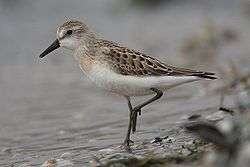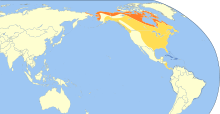Semipalmated sandpiper
The semipalmated sandpiper (Calidris pusilla) is a very small shorebird. The genus name is from Ancient Greek kalidris or skalidris, a term used by Aristotle for some grey-coloured waterside birds. The specific pusilla is Latin for "very small".[2]
| Semipalmated sandpiper | |
|---|---|
 | |
| Scientific classification | |
| Kingdom: | Animalia |
| Phylum: | Chordata |
| Class: | Aves |
| Order: | Charadriiformes |
| Family: | Scolopacidae |
| Genus: | Calidris |
| Species: | C. pusilla |
| Binomial name | |
| Calidris pusilla (Linnaeus, 1766) | |
 | |
| Synonyms | |
| |
It is sometimes separated with other "stints" in Erolia, but, although these apparently form a monophyletic group, the present species' old genus Ereunetes had been proposed before Erolia.
Description
It is a small sandpiper, 13–15 cm (5.1-5.9 in) long and weighing around 20-32 g (0.7-1.1 oz).[3] Adults have black legs and a short, stout, straight dark bill. The body is dark grey-brown on top and white underneath. The head and neck are tinged light grey-brown. This bird can be difficult to distinguish from other similar tiny shorebirds, in particular the western sandpiper; these are known collectively as "peeps" or "stints".
Breeding and habitat
Their breeding habitat is the southern tundra in Canada and Alaska near water. They nest on the ground. The male makes several shallow scrapes; the female chooses one and adds grass and other material to line the nest. The female lays 4 eggs; the male assists in incubation. After a few days, the female leaves the young with the male; the young feed themselves.
These birds forage on mudflats, picking up food by sight and feel (bill). They mainly eat aquatic insects and crustaceans.
Status and migration
They are long distance migrants and winter in coastal South America, with some going to the southern United States and the Caribbean. They migrate in flocks which can number in the hundreds of thousands, particularly in favoured feeding locations such as the Bay of Fundy and Delaware Bay. This species is a rare but regular vagrant to western Europe.
Although very numerous, these birds are highly dependent on a few key stopover habitats during their migration, notably Mary's Point and Johnson's Mills along Shepody Bay, an arm of the Bay of Fundy.[4] During the months of July and August, the Nature Conservancy of Canada runs an information center about these shorebirds in Johnson's Mills, New Brunswick.[5]
References
- BirdLife International (2012). "Calidris pusilla". IUCN Red List of Threatened Species. 2012. Retrieved 26 November 2013.CS1 maint: ref=harv (link)
- Jobling, James A (2010). The Helm Dictionary of Scientific Bird Names. London: Christopher Helm. pp. 84, 325. ISBN 978-1-4081-2501-4.
- Cornell Lab of Ornithology. "Semipalmated Sandpiper". All About Birds. Cornell University. Retrieved 3 August 2016.
- "Shepody National Wildlife Area". Archived from the original on 26 August 2017. Retrieved 29 April 2014.
- "NCC: Johnson's Mills Shorebird Reserve and Interpretive Centre". Nature Conservancy Canada. Archived from the original on 14 June 2018. Retrieved 9 January 2014.
Further reading
Identification
- Jonsson, Lars & Peter J. Grant (1984) Identification of stints and peeps British Birds 77(7):293-315
External links
| Wikimedia Commons has media related to Semipalmated sandpiper. |
| Wikispecies has information related to Calidris pusilla |
- Semipalmated sandpiper species sccount - Cornell Lab of Ornithology
- Semipalmated sandpiper - Calidris pusilla - USGS Patuxent Bird Identification InfoCenter
- Johnson's Mills Shorebird Reserve and Interpretive Centre
- An online identification article covering this species and other small calidrids at surfbirds.com
- "Semipalmated sandpiper media". Internet Bird Collection.
- Semipalmated sandpiper photo gallery at VIREO (Drexel University)
- Interactive range map of Calidris pusilla at IUCN Red List maps
- Semipalmated sandpiper - BirdLife International
